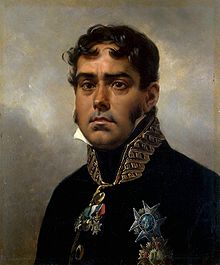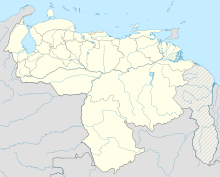Battle of Matasiete
| Battle of Matasiete | |||||
|---|---|---|---|---|---|
| Part of the Venezuelan War of Independence | |||||
 Monument on the battle ground | |||||
| |||||
| Belligerents | |||||
|
|
| ||||
| Commanders and leaders | |||||
| Francisco Esteban Gómez | Pablo Morillo | ||||
| Strength | |||||
| 300-1,300[a] | 3,000[2] | ||||
Location within Venezuela | |||||
The Battle of Matasiete was a battle in the Venezuelan War of Independence that took place on 31 July 1817 near the city of La Asunción on Isla Margarita in Venezuela. It was fought between pro-independence Republican revolutionaries led by Francisco Esteban Gómez and Spanish Royalist forces under the command of Pablo Morillo. The outcome was a Spanish defeat.
Background
The revolutionary leader Simón Bolívar arrived in the island of Margarita in May 1816.[4] On 6 May 1816 Bolívar declared the Third Republic of Venezuela and an Assembly of Notables recognized Simón Bolívar as Supreme Chief in the church of Santa Ana.[5] Bolívar then went on to the mainland. That year the Republicans were generally successful in their struggle with the Royalist forces.[4] The Spanish general Pablo Morillo returned to Venezuela in December 1816, and decided to first take Margarita, then move on to Guayana Province, both important Republican bases.[4] After some difficulties in collecting supplies and troops, Morillo sailed to Margarita in late June 1817, where he steadily gained control in a hard-fought campaign.[6]
On 24 July 1817 Morillo occupied the San Carlos de Borromeo Fortress at Pampatar, at the southeast tip of the island a few miles from Asunción. The revolutionaries had evacuated the castle and withdrawn to Asunción, where they concentrated. They were followed by Morillo's forces.[7] The Spanish occupied the hill of Matasiete, which overlooked the city and its surroundings from the east, with a force of 2,000 infantry and 600 cavalry.[7] There was no resistance to this move.[8] The approach to the town was difficult, however, due to the rugged terrain that the defenders had fortified with redoubts, moats and parapets.[9]
Battle

On 31 July 1817 Morillo launched the assault, which began at eight thirty in the morning. The struggle was fierce, with the Spanish pressing hard against the defensive front.[1] In his later report on the battle, Morillo paid tribute to the stubborn courage of the republicans, who repelled repeated cavalry charges.[10] During the course of the fighting, many unarmed men and women from the town joined the defenders, taking up the arms of those who had been killed or wounded.[11] General Esteban Gómez himself was hit by bullets several times, and his horse was killed under him.[12]
The republican artillery batteries Carante and Libertad played an important role in the defense. The Libertad, commanded by Felipe Villalba, fired incessantly.[12] The patriots also rolled huge boulders down the slope into the Spanish line.[13] By four in the afternoon the battle had been decided, with the Republicans the victors. 559 of the royalist troops had been killed or wounded.[1] On 1 August Morillo retired to the fortified position of Pampatar, followed by Gómez with a harassing force of 200 infantry and 300 horsemen.[14]
Aftermath
The battle had saved the city, but the revolutionaries continued to lose ground to the Spanish in the island. By mid-August they held only Asunción and the fortaleza del norte.[6] Morillo then heard that the revolutionaries on the mainland had captured Ciudad Guayana on 18 July, occupied Baja Guayana on 3 August, and were threatening Caracas. Morillo left the island without completing the conquest, but was unable to recover Guayana. The Republicans were in a stronger position after the campaign of 1817 than they had been before.[6] La Asunción became the provisional capital of the independent Republic of Venezuela.[13]
A column has been erected on the site of the battle.[15] The Castillo de San Carlos de Borromeo in Pampatar displays a painting that commemorates the battle, the most popular item in its collection.[16] In 1974 Matasiete hill was decreed a Natural Monument of Margarita.[17] Gómez Municipality, Nueva Esparta, birthplace of the victorious general, is named in his honor.[18] The anniversary of the battle is now celebrated as a special holiday on Margarita.[19] On 31 July 2012 a reenactment of the battle was staged at the site by over 500 volunteers.[20]
References
Notes
Citations
- ^ a b c González Chaves 1879, p. 524.
- ^ a b Blanco 1883, p. 400.
- ^ González Chaves 1879, p. 525.
- ^ a b c Archer 2000, p. 220.
- ^ Maddicks 2011, p. 179.
- ^ a b c Archer 2000, p. 221.
- ^ a b Mitre 1890, p. 474.
- ^ Bolívar 1876, p. 10.
- ^ Mitre 1890, p. 475.
- ^ González Chaves 1879, p. 480.
- ^ Blanco 1883, p. 400-401.
- ^ a b Batalla de Matasiete: En Oriente.
- ^ a b Maddicks 2011, p. 162.
- ^ Blanco 1883, p. 402.
- ^ Fernandez 2006, p. 5.
- ^ Brushaber 1997, p. 137.
- ^ Jacome 1992.
- ^ Gómez: Margarita en tus manos.
- ^ Maddicks 2011, p. 161.
- ^ Guerrero 2012.
Sources
- Archer, Christon (2000). The Wars of Independence in Spanish America. Rowman & Littlefield. ISBN 978-0-8420-2469-3. Retrieved 20 May 2013.
{{cite book}}: Invalid|ref=harv(help) - Baralt, Rafael María; Díaz, Ramón (1887). Résúmen de la historia de Venezuela: -3. Desde el año de 1797 hasta el de 1830. Tiene al fin un breve bosquejo histórico que comprende los años de 1831 hasta 1837 (in Spanish). A. Bethencourt é hijos. p. 376. Retrieved 20 May 2013.
{{cite book}}: Invalid|ref=harv(help) - "Batalla de Matasiete". En Oriente (in Spanish). 13 March 2006. Retrieved 20 May 2013.
- Blanco, Eduardo (1883). Venezuela heroica: cuadros historicos: La victoria.--San Mateo.--Sitio de Valencia.--Maturín.--Invasión de los seiscientos.--La Casa Fuerte.--San Féliz.--Matasiete.--Las Quesaras.--Boyacá.--Carabobo (in Spanish). Impr. Bolivar. p. 400. Retrieved 20 May 2013.
{{cite book}}: Invalid|ref=harv(help) - Bolívar, Simón (1876). Documentos para la historia de la vida pública del libertador de Colombia, Perú y Bolivia [S. Bolívar] puestos par orden cronológico, y con adiciones y notas que la ilustran, par J.F. Blanco [and R. Azpurúa] (in Spanish). Retrieved 20 May 2013.
{{cite book}}: Invalid|ref=harv(help) - Brushaber, Susan (1 October 1997). Venezuela Alive. Hunter Publishing, Inc. ISBN 978-1-55650-800-4. Retrieved 20 May 2013.
{{cite book}}: Invalid|ref=harv(help) - Fernandez, Marsha (1 May 2006). Margarita Island's Complete Travel Guide. Lulu.com. ISBN 978-1-4116-7614-5. Retrieved 20 May 2013.
{{cite book}}: Invalid|ref=harv(help) - "Gómez". Margarita en tus manos (in Spanish). Retrieved 21 May 2013.
- González Chaves, Nicolas (1879). Estudio cronologico de la guerra de la independencia de la antigua Colombia (in Spanish). A. Lahure. p. 480. Retrieved 20 May 2013.
{{cite book}}: Invalid|ref=harv(help) - Guerrero, Cristina (25 July 2012). "Batalla de Matasiete se Escenificará el 31 de julio en Nueva Esparta". Iconos de Venezuela (in Spanish). Retrieved 20 May 2013.
{{cite journal}}: Invalid|ref=harv(help) - Jacome, Juan Carlos (1992). Nueva Esparta, an insular land. Editorial Arte. Retrieved 20 May 2013.
{{cite book}}: Invalid|ref=harv(help) - Maddicks, Russell (1 February 2011). Bradt Travel Guide Venezuela. Bradt Travel Guides. ISBN 978-1-84162-299-6. Retrieved 20 May 2013.
{{cite book}}: Invalid|ref=harv(help) - Mitre, Bartolomé; Lajouane, Félix (1890). Historia de San Martín y de la emancipación sud-americana (in Spanish). F. Lajouane. Retrieved 20 May 2013.
{{cite book}}: Invalid|ref=harv(help)

